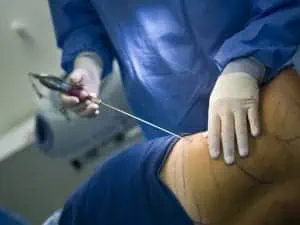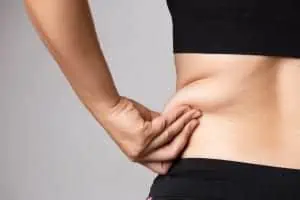 Medical Review By: Chris Cromwell, MD
Medical Review By: Chris Cromwell, MD
Liposuction is a surgical procedure that suctions fat cells from parts of the body that have not responded to diet and exercise. It’s not a weight loss surgery; rather, it improves the contours of specific areas of the body. Liposuction isn’t for people who are obese, and it isn’t an alternative to losing weight. It does not improve the appearance of cellulite.
While liposuction is relatively safe when performed on appropriate candidates, no surgery is risk free.
How does liposuction work?
When you gain weight, fat cells increase in size and volume, sometimes dramatically. While losing weight shrinks fat cells, it doesn’t remove them. Liposuction does.
Liposuction can be used to remove fat from the stomach, waist (love handles), hips, buttocks, chest, back, thighs, calves, face, chin, neck and upper arms. It’s possible to treat multiple areas during one procedure, though doing so raises the risk of complications. Depending on how many parts of your body you want to treat, the surgeon may recommend a second surgery.

During liposuction, the surgeon makes small incisions in the area(s) to be treated and inserts a slender, hollow tube called a cannula. The tube is connected to a vacuum that suctions excess fat. Depending on how much fat will be removed, you’ll receive either local or general anesthesia.
Liposuction results
The results of liposuction are more subtle than dramatic. They are permanent, but only if you keep your weight stable. The fat cells that remain after the procedure can expand if you gain weight. In addition, with significant weight gain, new fat cells can develop in any part of the body, including the treated area, though the treated area will still look better than it did prior to liposuction.
Types of liposuction

- Tumescent liposuction. This is the most common type of liposuction. Before the incisions are made, the area to be treated is injected with a solution containing saline, epinephrine and a local anesthetic such as lidocaine. These fluids make fat removal easier, limit blood loss and numb the area.
- Ultrasound-assisted liposuction (UAL). In this approach, the surgeon inserts a special type of cannula that vibrates rapidly and releases ultrasound waves to liquefy the fat.
- Laser-assisted liposuction (LAL). A thin fiber releases thermal energy that melts the fat. LAL is considered a good approach for smaller areas of the body, such as the chin and face, because the cannula used is smaller than those used in other techniques.
- Power-assisted liposuction (PAL). Surgeons use a powered cannula with a vibrating tip, which allows for faster removal of fatty tissue and therefore less time spent under anesthesia. The surgeon may recommend this technique if he or she has to remove a large volume of fat.
To determine which method is best for you, the surgeon evaluates the fat in the areas of your body where you want liposuction. Fat that is more fibrous is harder to break down, so the surgeon may choose one of the assisted types of liposuction.
Liposuction recovery
In most cases, you are able to go home the day of the procedure, though you may require an overnight hospital stay if you’ve had a lot of fat removed. Your surgeon may place temporary drains in your incisions to remove excess blood or fluid. You’ll be given a compression garment to wear for one to two months following the procedure to control swelling.
In addition to swelling, you can expect some pain and bruising after liposuction. You may be prescribed pain medication and antibiotics to reduce the risk of infection. If the treated areas don’t appear smooth at first, don’t worry; it’s normal to see some contouring irregularities as the remaining fat settles into position.
You should be able to return to your normal activities, such as exercise, in about two weeks. Most people can go back to work in a few days. It may take up to six months, or in some cases longer, to see full results.
Liposuction risks
While advances in liposuction techniques have made the procedure safer than ever, the procedure does pose risks, some of which are serious. Potential complications include:
- Reactions to the anesthesia or lidocaine
- Scars
- Infection
- Blood clots
- Fat embolism (when fat breaks loose and lodges in a blood vessel)
- Temporary or permanent numbness
- Temporary fluid accumulation under the skin (seromas)
- Changes in skin color
- Lumpy, dimpled or loose skin
- Injuries to nerves, blood vessels or muscles
- Puncturing of organs such as the lungs and stomach by the cannula
- Burns or heat injuries from an ultrasound probe
- Heart and kidney problems due to fluid imbalances
Who can get liposuction?
Some people are better candidates for liposuction than others. You may not be a good candidate if:
- You smoke
- You are not within 30% of your ideal weight
- You have a lot of excess skin
- You have a chronic health problem such as diabetes or a history of deep vein thrombosis (DVT)
You may be a good candidate for liposuction if:
- You’re close to your ideal weight
- Your skin is firm and elastic
- You’re in good physical shape, with good muscle tone
- You have realistic expectations
If you’re considering liposuction, make an appointment with a board-certified plastic surgeon. He or she will determine whether it’s a good option for you and discuss the risks and benefits of the procedure.
Article Written By: Jessica Brown, a health and science writer/editor based in Brooklyn, New York. Her work has appeared in Prevention, Johnson & Johnson, the Breast Cancer Research Foundation, and many more.




 Medical Review By:
Medical Review By: 
